
- Index
- Framing
- Listed By
- Material
- Style
- Abstract (20)
- Abstract, Modernism (6)
- Americana (5)
- Art Deco (9)
- Art Nouveau (5)
- Art, Realism (4)
- Dutch (5)
- Dutch, Realism (5)
- Expressionism (29)
- Folk Art (10)
- Impressionism (165)
- Impressionist (5)
- Modernism (13)
- Portraiture (7)
- Realism (182)
- Still Life (22)
- Traditional (10)
- Traditional, Realism (4)
- Victorian (22)
- Vintage (60)
- Other (564)
- Subject
- Type
Signed Antique French Impressionist Oil Painting Henri Le Riche
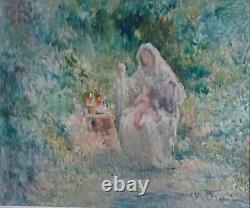
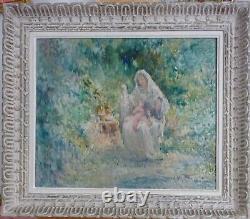
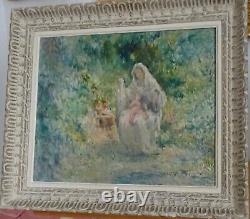
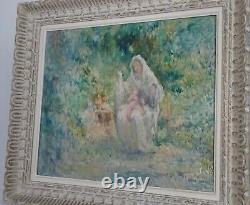
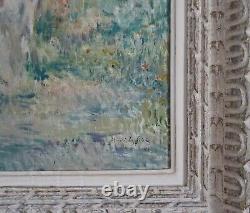

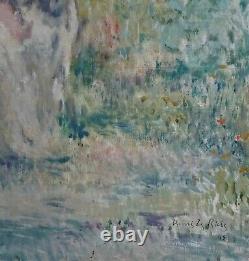
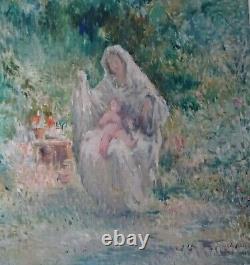
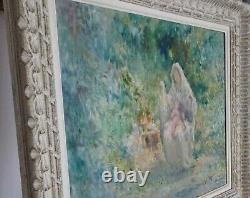
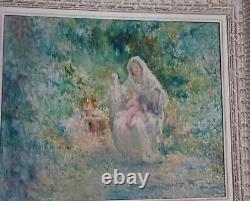
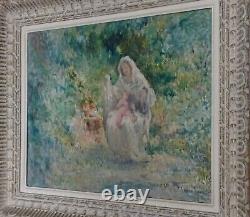

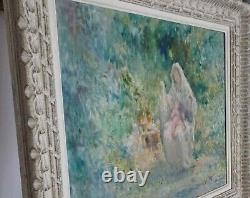
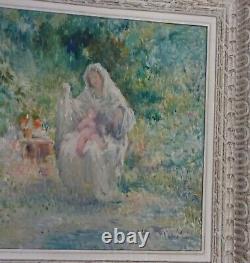


Vierge à l'Enfant dans un jardin fleuri. ("Madonna and Child in a Flowered Garden"). Antique Signed French Impressionist Oil Painting On Original Canvas, Henri Le Riche.
Le Riche studied with Eustache Bernard for three years, at the École Supérieure d'Art de Grenoble. In 1887, he enrolled at the École des Beaux-Arts in Paris, where his primary instructors were the famed William Bouguereau and Tony Robert-Fleury and Louis Pierre Henriquel-Dupont. In 1888 Henri Le Riche won the Grand Prix de Rome, and spent three years at the Villa Medici. A visit to China and Japan inspired a number of his paintings.
Upon completing his studies in Rome, he visited North Africa with one of his fellow students, the architect Albert Tournaire. Le Riche illustrated numerous books, including Alfred de Musset's Venice, Gobineau's Nouvelles asiatiques, Gillet's La Cathédrale de Chartres, and many others. He also worked as an enamelist and goldsmith, and was known as a sculptor under the name Hirné. His works are characterized by a high quality of composition and draughtsmanship. His first individual exhibit was at the Paris Salon des Artistes in 1894 and the Salon de la Societé Nationale des Beaux-Arts. In 1922 Henri Le Riche won his first silver medal, and was made a Chevalier de La Légion d'Honneur. Le Riche was represented in the exhibition Le Portrait en Dauphine. His paintings have been exhibited frequently in Paris, Grenoble, London and the USA. Some of his sculptures were signed with the name "Hirné". In 1935, Le Riche was elected to the Académie des Beaux-Arts, where he took honors for engraving, succeeding Frédéric Laguillermie; serving as its President in 1943.He illustrated works by Jean d'Esme, Claude Farrère, Arthur de Gobineau, and Charles Baudelaire, among many others. Some of his original plates may be seen at the Musée de Grenoble. The Impressionist Movement caused a major shakeup in the world of art.
Impressionism was a 19th-century art movement that began as a loose association of Paris-based artists whose independent exhibitions brought them to prominence in the 1870s and 1880s. Characteristics of Impressionist paintings include visible brush strokes, open composition and particular emphasis on light in its changing qualities.Impressionism developed in France in the nineteenth century and is based on the practice of painting out of doors and spontaneously en pleine air (outdoors) rather than in a studio from sketches. Many impressionist subjects were landscapes and scenes of everyday life. The painting offered today, Vierge à l'Enfant dans un jardin fleuri, is fresh to the market, and purely evocative of the real meaning of Impressionism.
Henri Le Riche has truly evoked the play of light in this painting of a mythological subject, demonstrating a mastery of color, harmony, and beauty of line. He is here a true master of composition and economy of artistic expression.
The painting offered today, Vierge à l'Enfant dans un jardin fleuri, is an incredibly lovely Impressionist painting. The subject itself is totally, almost overwhelmingly serene and beautiful. The Impressionists were considered extremely progressive and radical in their work.
They rejected nearly all the "rules" of the currently-reigning Academic School of art. Their goal was to capture "reality" as they saw it, often using short brushstrokes, candid "snapshot" painting stressing the immediacy of the moment. Of course, the art-viewing public initially rejected the very concept of Impressionism. It was many years before the public at large came to accept Impressionism. Today of course, it is perhaps the most sought-after form of art.
In the scholarly book "Impressionist Painting, its Genesis and development, " by Wynford Dewhurst, Dewhurst calls the Impressionists all artists of the rarest temperaments. High praise indeed, but certainly no exaggeration in the case of Henri Le Riche. The painting offered here is fresh to the market, and purely evocative of the real meaning of Impressionism. Le Riche has truly mastered light in this painting of a striking floral garden demonstrating a mastery of color, harmony, and beauty of line. The oil paintings of Henri Le Riche have been sought and collected for generations, with steadily-increasing values. They are held in numerous museums, including the Orsay, in Paris, The Baltimore Museum, etc. Just a few examples include.Arabe et son cheval dans la kasbah de Tunis. Clair de lune sur un étang. A pagoda along the river in Kampong Luong. Vierge à l'Enfant dans un jardin fleuri is clearly signed and dated "42" by the artist on lower right foreground, as shown.
Vierge à l'Enfant dans un jardin fleuri measures 27 5/8 inches x 24 1/4 inches framed in original antique Montparnesse frame, and 25 inches x 19 inches unframed. Carved wooden "Montparnasse" frames were in vogue in the early 20th century to the 1940s, framing the paintings of painters from the School of Paris, of the Montparnasse district from which they take their name. Their main characteristics are: a clear and imperfect patina as well as a roughly carved wood.
The decor takes up the ornamental repertoire of previous eras (mainly in the Louis XIV style) while being in search of a raw, aged, imperfect appearance. These frames are suitable for early 20th century paintings and know perfectly how to highlight the bright and expressive colors of the Impressionist paintings, as seen here in Vierge à l'Enfant dans un jardin fleuri.
Vierge à l'Enfant dans un jardin fleuri is offered at a surprisingly reasonable reserve for an ancient oil on canvas painting of such remarkable style, color and beauty. Please write with any questions and/or comments regarding Vierge à l'Enfant dans un jardin fleuri. Please excuse my amateur photography; Vierge à l'Enfant dans un jardin fleuri is in superb original condition.My main stock in trade are original antique oil paintings. I specialize in fine 17th through 20th century, Old Master, Impressionist and Orientalist paintings, in all price ranges.
N O T E: Please ignore the one under-exposed photo seen- it is my error.

